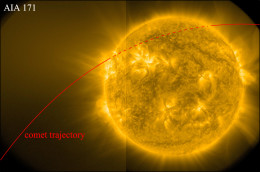On 28 November 2013, comet C/2012 S1 — better known as comet ISON — should have passed within two solar radii of the Sun’s surface as it reached perihelion in its orbit. But instead of shining in extreme ultraviolet (EUV) wavelengths as it grazed the solar surface, the comet was never detected by EUV instruments. What happened to comet ISON?
Missing Emission
When a sungrazing comet passes through the solar corona, it leaves behind a trail of molecules evaporated from its surface. Some of these molecules emit EUV light, which can be detected by instruments on telescopes like the space-based Solar Dynamics Observatory (SDO).
Comet ISON, a comet that arrived from deep space and was predicted to graze the Sun’s corona in November 2013, was expected to cause EUV emission during its close passage. But analysis of the data from multiple telescopes that tracked ISON in EUV — including SDO — reveals no sign of it at perihelion.
In a recent study, Paul Bryans and Dean Pesnell, scientists from NCAR’s High Altitude Observatory and NASA Goddard Space Flight Center, try to determine why ISON didn’t display this expected emission.
Comparing ISON and Lovejoy

In December 2011, another comet dipped into the Sun’s corona: comet Lovejoy. This image, showing the orbit Lovejoy took around the Sun, is a composite of SDO images of the pre- and post-perihelion phases of the orbit. Click for a closer look! The dashed part of the curve represents where Lovejoy passed out of view behind the Sun. [Bryans & Pesnell 2016]
- the coronal conditions experienced by the two comets were not similar, or
- the two comets themselves were not similar.
To establish which factor is the most relevant, the authors first demonstrate that both comets experienced very similar radiation fields as they passed perihelion. They also show that the properties of the Sun’s corona experienced by each comet — like its density and magnetic field topology — were roughly the same.
Bryans and Pesnell argue that, as both comets appear to have encountered similar solar conditions, the most likely explanation for ISON’s lack of detectable EUV emission is that it didn’t deposit as much material in its orbit as Lovejoy did. They show that this would happen if ISON’s nucleus were four times smaller in radius than Lovejoy’s, spanning a mere 50–70 meters in comparison to Lovejoy’s 200–300 meters.
This conclusion is consistent with white-light observations of ISON that suggest that, though it might have started out significantly larger than Lovejoy, ISON underwent dramatic mass loss as it approached the Sun. By the time it arrived at perihelion, it was likely no longer large enough to create a strong EUV signal — resulting in the non-detection of this elusive comet with SDO and other telescopes.
Citation
Paul Bryans and W. Dean Pesnell 2016 ApJ 822 77. doi:10.3847/0004-637X/822/2/77

1 Comment
Pingback: La luz perdida de un cometa « SEDA / LIADA